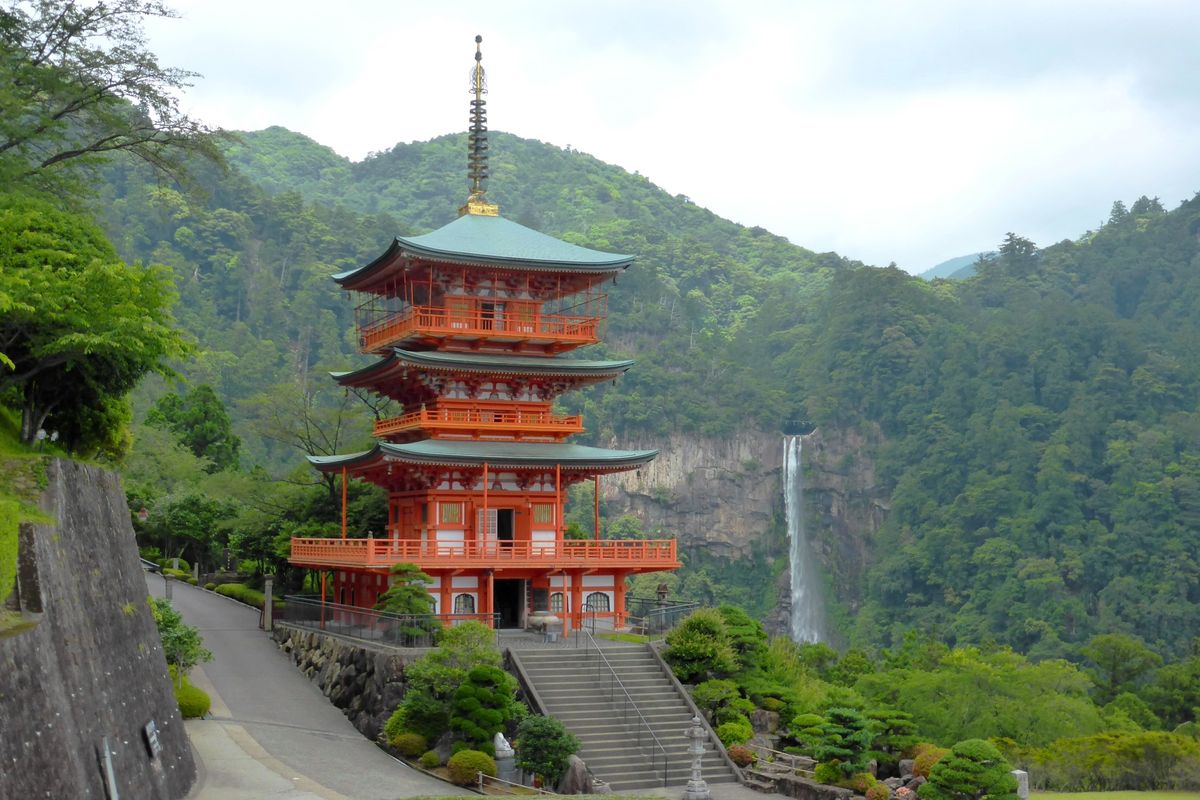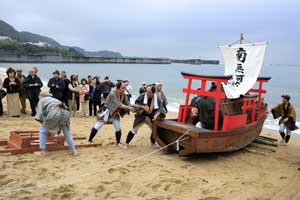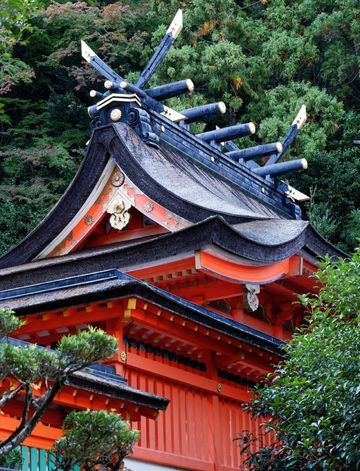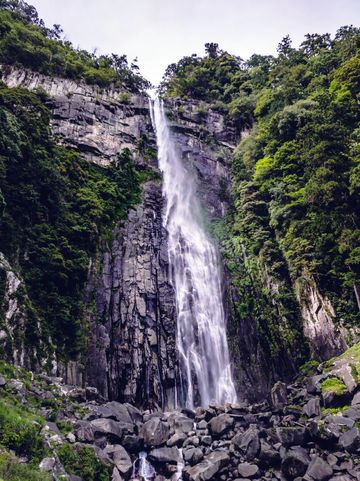
Seiganto-ji (青岸渡寺), translated as “Temple of Crossing the Blue Shores” is a Buddhist temple in Wakayama Prefecture, Japan. It is a member of the Tendai-Sanmon sect, and is the first temple of the Saigoku Kannon 33 Pilgrimage.
Seiganto-ji was designated as a UNESCO World Heritage Site in 2004, and is also listed as an official “Important Cultural Property of Japan” by Japan's Agency for Cultural Affairs.

Set in the primeval forests of Kumano, in a region steeped in mystical legends and overlooking Japan’s tallest uninterrupted waterfall (Nachi Falls), Seiganto-ji’s long history dates back into the mists of time. For well over a thousand years it has also been a meaningful destination.
During the middle ages, the journey from Kyoto to Kumano became so popular with emperors, nobility, and common people alike that the pilgrimage route was said to be “like a trail of ants.” With the Nachi Waterfall, the imperially-protected virgin forests, the ancient mountain paths, and the coastline dotted with fishing hamlets and hot springs, Seiganto-ji continues to be a popular destination for nature lovers as well as pilgrims of Kannon.
Things to See at Seiganto-ji
Sanjūdō Pagoda
To commemorate 300 years since the previous pagoda was burned down, the new Sanjūdō pagoda was built in 1971. Inside there are a number of important treasures, including an image of Senjū Kannon as a manifestation of Hiro Gongen (“Flying Waterfall” – the kami, or god, of the Nachi Falls).
The top of the pagoda boasts a spectacular view. There is even an elevator!

From the pagoda down to the Nachi waterfall, there is a 100 meter walk along an ancient stone pathway. It passes through a cherry tree grove and the remains of the temple that once housed the Kannon of the waterfall. It is along this narrow stone path that the famous Nachi fire festival is held.
The "Sanmon" Mountain Gate
Seiganto-ji's Sanmon (Mountain Gate) is the entry to the upper temple grounds. There are about 500 stone steps leading up to the temple with little souvenirs shops lining the route on both sides.

At the majestic vermillion-colored gateway, there are a pair of protective guardians (called the "Kongōrikishi") which were carved by the famous Kamakura era sculptor Tankei (1173 – 1256). On the other side is a pair of Shishi (獅子) lion-dogs with wonderful snarling faces.
The Main Temple
The Hondō of Seiganto-ji is called the Nyoirindō (The Temple of the Wish-fulfilling Kannon). The temple was rebuilt in 1587 by Toyotomi Hideyoshi, the post-war shogun who unified Japan, during which the entire mountain complex was razed.

It is typical of Momoyama Era style of architecture with a distinctive shingled roof called "irimoya." The Nyoirindō is the oldest extant building in the southern Kii region, and is heritage listed as a National Important Cultural Property of Japan.
Waniguchi "Crocodile Mouth" Gong
During work on the restoration of the temple, Hideyoshi contributed a 1.45 meter wide cast bronze waniguchi gong. The gong, which draws crowds, is inscribed with a prayer for the safety and long life of Hideyoshi’s descendants in perpetuity, written in 1591.

Waniguchi gongs are associated with mountain practices and are only found in mountain temples. It is the largest bell of its type in Japan and is heritage listed as a National Important Cultural Property. It takes some practice to learn how to make the bell ring... it requires a kind of flicking motion of the rope. When you visit, be sure to try it!
The Hall of Lanterns
The Hall of Lanterns, called the Nyohōdō, is located up the stairs behind the Hondo. It is dedicated to Daikokuten, a popular god of wealth who is one of the Seven Lucky Gods. Many colorful red paper lanterns hang from the roof that have been donated by visitors. There is a wonderful old statue of Daikokuten, with his portly belly, magic mallet of gold coins, and a cheeky smile!

Sonsho-in Abbot's Quarters
Note: Now closed
The Sonsho-in temple used to the abbot’s quarters, and commands a spectacular view of the waterfall and surrounding mountain forests. Visitors used to be able to stay overnight at this temple inn and enjoy the delicious Buddhist cuisine. Guests could hear the waterfall thundering through the night, walk through the beautiful garden at dawn for the early morning service at the Hondo, and then visiting the waterfall without any tourists. A stay at the Abbot's Quarters offered a rare opportunity to experience the mystical atmosphere of this sacred place.

Legends and History of Seiganto-ji
Ragyō Shōnin
During the reign of Emperor Nintoku (313-399), a famous priest named Ragyō Shonin (“The Naked Saint”), while traveling back to his home in India, was shipwrecked in stormy seas off the Kii Peninsula and was cast ashore on the Kumano coast. In the dark night, he saw a stream of golden light coming from Mt. Nachi, and so he set out towards the mountains in order to discover the source of the mysterious light.

Following the river he ventured deeper and deeper into the mountains until he arrived at Nachi Waterfall, which was shimmering like a ribbon of light. Ragyō decided to remain here until he completed the grueling ascetic practice known as "The One Hundred Day Waterfall." Night and day he stood beneath the thundering waterfall, which severely lashed and pounded his body.
On the morning of the final day, the waters parted, revealing a tiny golden image of Kannon, glowing radiantly. The image then flew towards the weary holy man and alighted on his arm. Ragyō was so profoundly moved by this experience that he installed the image in the small hermitage that he had built and worshipped Kannon until he died right there on the mountain.
Shōbutsu Shōnin
After Ragyō’s death, no one ventured into the wilderness of Mt. Nachi. One day, during the reign of Empress Suiko (592-628), a holy man by the name of Shōbutsu Shōnin had a dream.
In this dream, Kannon told Shōbutsu to leave his home in Yamato and to travel to Kumano in search of Ragyō’s golden statue of Kannon. When he arrived at Nachi Waterfall, he began ascetic practices beneath Nachi Falls, in the same manner that Ragyō had done three hundred years before.
Shōbutsu decided that he would stay under the waterfall until he had a vision telling him where the statue was to be found. However, it was only the start of spring when Shōbutsu arrived at Nachi, and the water was still icy cold. After only three days and nights of practicing in severe conditions, Shōbutsu lost consciousness, his body became frozen stiff and he started to float away down the river towards the ocean.
After he began floating, a young child suddenly appeared, who waded into the water and rescued Shōbutsu. "Who are you?," Shōbutsu asked. But the child just smiled wide and said, “I have been sent as a messenger to warn you that extreme practices are not the Middle Way of the Buddha.” Then the child just as suddenly disappeared, and Shōbutsu realized that the child was a manifestation of Kannon.
In the place where the child disappeared, Shōbutsu saw a light glowing from under the ground. When he dug there, he found the tiny golden statue of Kannon. Shōbutsu then carved a larger- than-life sized statue of Kannon and placed the golden image inside at its heart. This is the statue that is venerated to this day as the “Nachi Kannon” at Seigantoji Temple.
Izumi Shikibu
There were many emperors who made pilgrimage to the thirty-three sacred places of Western Japan. Among them was Emperor Go-Shirakawa, who undertook Saigoku 33 Pilgrimage thirty-three times.

At Seiganto-ji, Emperor Go-Shirakawa wrote a sacred poem dedicated to Kannon in the form of Kumano Gongen:
'Oh Bodhisattva, in praying to you for freedom from the bonds of suffering, surely here in Buddha’s sacred precincts I shall receive an answer to my prayers. With this sacred poem in mind, Izumi Shikibu came to Kumano to visit the temple. However, because she was menstruating she had to remain at the base of the mountain. Feeling frustrated, she wrote this poem:
"I feel as though my whole being has been overcast by heavy clouds. How sad that because of my physical condition I cannot raise myself from this bed and journey on up to the temple! I dreamt that Kannon appeared to me in the form of the Kumano Gongen and told me that she was the origin of the story of the Wakodojin, the Bodhisattva who, in disguise, moves amongst us in unexpected ways in order to save us. Surely, the reason why menstruation stopped me from completing the pilgrimage was so that I might have this vision.'
Izumi Shikibu saw that the significance of her own pilgrimage experience was so that the Kannon could personally reply to the emperor’s poem. There are many such stories about miracles associated with the pilgrimage – too many for me to enumerate in detail. Instead, I offer you my series of paintings to tell you about a few of the miracle stories about Kannon.'
This story is an English translation of the words painted on woodblock prints made during the Edo era. These prints show the temple grounds in the upper portion, and illustrate one of the temple legends in the main body of the picture.
Kannon's Paradise Island
For over a thousand years, up until the late 19th century, many of the abbots of this temple set out to sea on a small rudderless boat when they turned 60 years old. This practice was called "Fudaraku Tōkai," and is one of the "Shashin Gyo" trainings in which priests performed an act of self-sacrifice for the purpose of human salvation.

People entrusted the priests to carry their prayers for happiness and enlightenment to Fudaraku (Potala in Sanskrit) Island, Kannon’s Paradise, which was said to lie somewhere off the southern coast. There is a replica of the boat housed in a special pavilion at the temple which shows the boat to have been built as a sailing shrine, surrounded by red shrine fences and a torii gate like you can see at any shrine. The priests were given token provisions and pushed out to see from the shoreline that is about hundred meters directly in front of the temple. The temple's name Seiganto-ji translates as "Mt. Potala," or Kannon’s Paradise.
Images of Seiganto-ji
The principle image of Seiganto-ji is Nyoirin Kannon. There are two additional images as well: Kannon Bosatsu and Dainichi Nyōrai.
Nyoirin Kannon
Originally, there were two principal images enshrined at Seigantoji: the Nyoirin Kannon that is enshrined in the Hondō, and a Senjū Kannon that was enshrined in a temple at the foot of the waterfall. The Senjū Kannon was destroyed during the Meiji Restoration when Buddhist elements were removed from Shintō shrines all around Japan.
The Nyoirin Kannon is enshrined in the Hondō is the principal image of veneration. It is a secret image shown only once a year, on August 17th. This 3-meter high wooden image was carved by Shobutsu Shonin during the reign of Empress Suiko (who reigned from 592 – 628). Inside its chest cavity, there is a small golden image of Kannon said to be just "1 sun and 9 bu" (about 6 centimeters).
This tiny golden Kannon was said to be the personal image that Ragyō the hermit enshrined in his hermitage in the 4th century. However, it is more likely to have been the personal image belonging to Empress Suiko. The image is unusual because it has six arms, and usually images of Nyoirin Kannon have only four arms.
Kannon Bosatsu
This delightful gilt bronze image, dating from the Hakuhō period (646 – 710), is one of the oldest statues of Kannon in Japan. It was excavated from under the sutra mound near the entrance to Nachi Falls in 1918.

Dainichi Nyōrai
Also found in the sutra mound was this beautifully preserved gilt bronze image of Dainichi Nyorai, dating from the Fujiwara period (898 – 1195). Known in Sanskrit as the Maha-Vairocana – Universal Buddha of Light, he is shown in a seated position with the Kongokai mudra. This deity is the key figure of veneration within the Japanese Esoteric Buddhist tradition.

Goeika of Seigantoji
Written by Emperor Kazan
Fudaraku ya Kishi utsu nami wa Mikumano no Nachi no oyama ni Hibiku taki tsuse
On Kannon’s island paradise, Waves crash upon the shores; In the sacred land of Kumano, Down Nachi Mountain, The thundering waterfall cascades.



